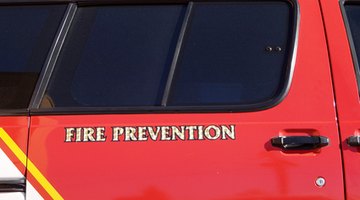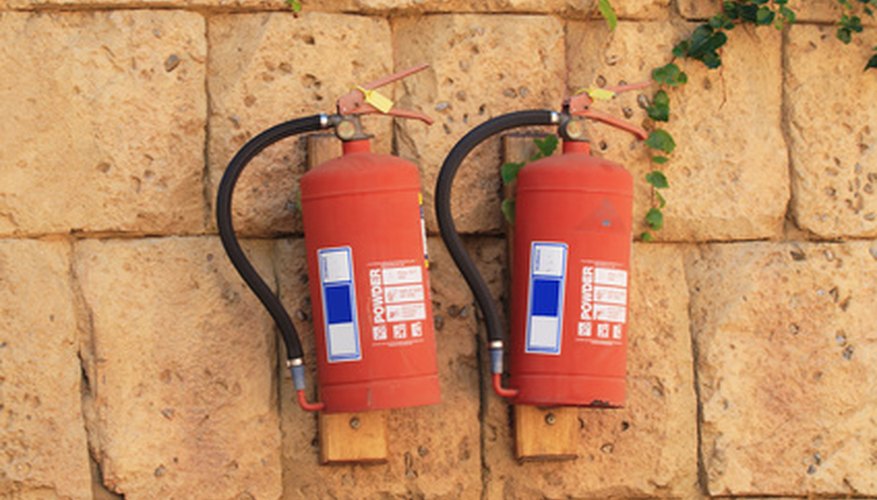According to the National Fire Protection Association, one in every seven house fires is caused by electrical equipment failure. While computers are relatively low on the list of appliances that cause fires, it is important to use the proper kind of fire protection near your expensive equipment. As we learn in childhood, electricity and water can be a dangerous combination. Therefore it is critical to not use a water-based fire extinguisher around a computer, or anything else that plugs into your wall.
Types
There are four different classes of fire extinguishers, classified by letter:
Class A are water-based extinguishers for paper and wood fires. Class B extinguishers are suitable to put out flammable liquid fires, such as gasoline and oil. Class C contain non-conductive agents for putting out electrical fires. Class D are the least common type of extinguisher, and are used for chemical fires in laboratories. Class K extinguishers are used to put out fires in professional restaurant kitchens, such as around deep fryers.
- There are four different classes of fire extinguishers, classified by letter: Class A are water-based extinguishers for paper and wood fires.
- Class D are the least common type of extinguisher, and are used for chemical fires in laboratories.
Multipurpose fire extinguishers that cover more than one class are usually dry-agent based, as opposed to water-based, and are convenient for home use.
Considerations
Carbon dioxide-based (CO2) fire extinguishers cause the least amount of damage to computer equipment and are appropriate for Class B and C fires. This type of extinguisher uses compressed gas to extinguish the fire, and could cause re-ignition of Class A materials. If there is paper or wood burning near your computer, use an appropriate extinguisher and take care to point it away from your computer equipment if at all possible.
While dry-chemical and multipurpose fire extinguishers are rated for both Class B and C fires, they leave a residue that can harm computer equipment. If you are using this type of extinguisher near your computer, make sure that you clean the surface of the machine to minimise damage.
- Carbon dioxide-based (CO2) fire extinguishers cause the least amount of damage to computer equipment and are appropriate for Class B and C fires.
- While dry-chemical and multipurpose fire extinguishers are rated for both Class B and C fires, they leave a residue that can harm computer equipment.
Class C Extinguishers
Class C extinguishers can contain foam, fire suppressing chemicals or compressed non-flammable gas (carbon dioxide or halon). According to the Hanford Fire Department, they work by either "interrupting the chemical reaction that takes place when fuels burn" or by displacing and cooling the surrounding air. These extinguishers have a very short range and must be used even after it appears that the fire has been extinguished.
- Class C extinguishers can contain foam, fire suppressing chemicals or compressed non-flammable gas (carbon dioxide or halon).
- According to the Hanford Fire Department, they work by either "interrupting the chemical reaction that takes place when fuels burn" or by displacing and cooling the surrounding air.
When you use a fire extinguisher, remember the acronym PASS:
Pull the safety pin; Aim at the base of the fire; Squeeze the handle; Sweep the nozzle back and forth.
Prevention/Solution

To maintain the highest level of safety for your home, keep the proper kind of fire protection equipment near the likely source of each type of fire; Class C near your computer, Class B in the kitchen and so on. This will prevent you from grabbing the wrong kind of extinguisher in the event of an emergency.
- To maintain the highest level of safety for your home, keep the proper kind of fire protection equipment near the likely source of each type of fire; Class C near your computer, Class B in the kitchen and so on.
Additionally, please check your electrical sockets and equipment regularly for signs of failure. It is particularly important to check the wiring in older homes where the wiring may not be up to current fire codes. Use surge protectors on your equipment, and try not to use extension cords for long periods of time.
Expert Insight
There are numerous places to receive free fire-safety consultations and expert advice. The National Fire Protection Association (NFPA) has consumer resources for fire safety, including a section on Electrical Fire Prevention and Protection. Often, each state and municipality will have its own fire prevention and protection codes, which are regulated by the fire marshals. Lastly, your local fire brigade will be able to advise you on fire protection in your home. Fire brigades would much rather prevent fires than fight them.
- There are numerous places to receive free fire-safety consultations and expert advice.
- The National Fire Protection Association (NFPA) has consumer resources for fire safety, including a section on Electrical Fire Prevention and Protection.
